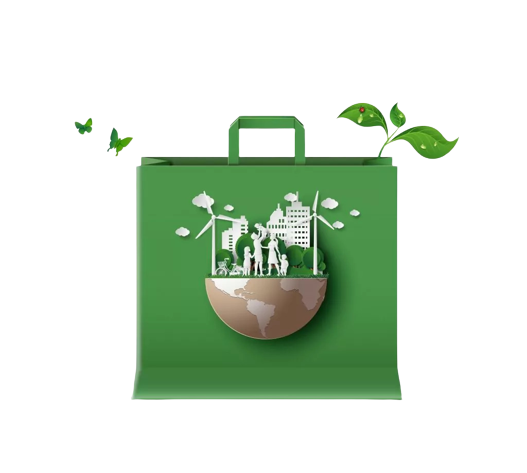Introduction
Most households purchase milk daily, but have you ever considered where it originated? The majority of milk is packaged in plastic bags that do not break down naturally. Some stores began selling biodegradable milk bags a couple of years ago as a more environmentally friendly option. Are the bags better for you than plastic bags? Let’s get to the facts.
What are biodegradable milk pouches?
Biodegradable milk bags are unique bags constructed from a substance known as bioplastics that will naturally biodegrade over time. Unlike plastic bags, biodegradable milk bags disintegrate into non-toxic substances. Firms producing environmentally friendly items such as trash bags and biodegradable shopping bags now produce biodegradable milk packaging to minimize plastic waste.
What is a plastic milk bag?
Plastic milk pouches are ubiquitous supermarket packaging. They are inexpensive to produce and readily available. The issue is that they do not biodegrade. Similar to plastic grocery bags, they will linger in landfills or oceans for decades. Though in theory recyclable, the majority of plastic milk pouches are simply waste.
Key Differences Between Plastic and Biodegradable Milk Bags
When you purchase milk on a morning commute, it is likely that it is packed into a plastic bag. It is low-cost, convenient to transport, and has been popular for decades. However, it has one flaw – those small plastic milk bags do not magically disappear when they get tossed into the garbage. It remains for hundreds of years, causing gradual damage to the environment.
The solution is biodegradable milk pouches that decompose normally. Their design and functionality will be almost the same as the previous version, except that the primary difference lies after usage. We will clarify the key differences between plastic and biodegradable milk pouches in a very simple manner.
- What They Are Made From
Plastic Milk Pouches– Made of petroleum-based plastic (like polyethylene). Strong, but not biodegradable.
Biodegradable Milk Pouches – The biodegradable milk packs are made of plant materials like cornstarch, vegetables scraps, or sugar cane. These will get decomposed by nature and do not leave toxic byproducts.
- Impact on the Environment
Plastic Milk Pouches– It decomposes very slowly, usually taking several centuries. It mainly winds up on garbage dumps, sewers, or the sea, which poisons the environment and harms wildlife.
Biodegradable Milk Pouches– Decomposes within several months of composting environment. No permanent harm, no toxic byproducts.
- Food Safety
Plastic Milk Pouches – Still widely used today, though studies note concerns with microplastic substance and hazardous chemicals long term.
Biodegradable Milk Pouches – Generally safe and good for edibles, can hold milk and will not leak nor produce harmful substances.
- Cost Factor
Plastic Milk Bags – Cheaper because they’ve been mass-produced for decades.
Biodegradable Milk Bags – The biodegradable bags that were once more expensive will become cheaper faster as more and more of those will be used.
5. After Use –
Plastic Milk Bags – We cannot recycle them easily. We usually burn them or bury them, which produces hazardous gases or contaminates the earth.
Biodegradable Milk Bags – You can put them into a compostable garbage bag or get them composted. They get decomposed into water and carbon dioxide and leave nothing on the ground.
Benefits of Choosing Biodegradable Milk Pouches
Having some merits of employing biodegradable milk bags, including:
- Eco-Friendly: They break down, i.e., a shopping bag that can be composted.
- Safer for Nature: Sea and land animals are less affected by plastic pollution.
- Sustainable Living: Capitalizes on current customers who currently buy items like biodegradable apparel or dog poop bags to help reduce plastic use.
- Improved Brand Perception: Businesses utilizing biodegradable packaging are more likely to earn the trust and loyalty of consumers who are environmentally aware.
Challenges & Limitations of Biodegradable Milk Pouches
While environmentally friendly, biodegradable bags also pose a problem:
Expenses: They are more expensive to produce than plastic.
Storage: They require good conditions. Biodegradable, compostable cling wrap works best when kept dry.
These days, not everyone can easily get biodegradable packaging. Today, biodegradable bubble wrap is being utilized instead, and more biodegradable milk pouches will be utilized in the future, which will be cheaper soon.
Which Milk Pouch Should You Choose?
If you care for the world, biodegradable milk pouches are the way to go. Plastic pouches are cheap and easy now, but they harm the soil, sea, and wildlife in the long term. If you already have compostable grocery bags or biodegradable stretch film for packaging, the next thing to do is to make use of biodegradable pouches for milk.
Conclusion
Plastic vs. Biodegradable Milk Packs: The Future Lies in Biodegradable. The debate between plastic and biodegradable milk packs is evident — biodegradable is the future. As plastic rules the current era, biodegradable packs show us that the future will be different. Just as compostable garbage bags and compostable fashion bags are slowly replacing plastic bags, milk packs are also going to follow suit.
Frequently Asked Questions
Q1. Is milk capable of being stored in biodegradable milk packets?
Ans. Yes, they are designed to store milk safely and fresh without leaking or spoiling.
Q2. How long will milk pouches that break down naturally last?
Ans. It usually takes several months when the compost to be in its best condition.
Q3. Are biodegradable milk pouches recyclable?
Ans. No, they are designed to break down biologically, not recycled like plastic.
Q4. Is a biodegradable milk pouch more costly than a plastic pouch?
Ans. Yes, they are expensive these days, but their price will come down because more people will desire them and more will be produced.


